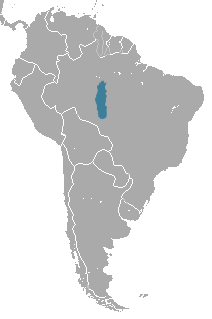| Ashy black titi [1] | |
|---|---|
 | |
| Scientific classification | |
| Kingdom: | Animalia |
| Phylum: | Chordata |
| Class: | Mammalia |
| Order: | Primates |
| Suborder: | Haplorhini |
| Infraorder: | Simiiformes |
| Family: | Pitheciidae |
| Genus: | Plecturocebus |
| Species: | P. cinerascens |
| Binomial name | |
| Plecturocebus cinerascens (Spix, 1823) | |
 | |
| Ashy Black Titi range | |
The ashy black titi monkey (Plecturocebus cinerascens) is a species of titi monkey, a type of New World monkey, endemic to Brazil. [2] It was originally described as Callithrix cinerascens in 1823. [2]
